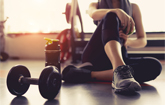ROSEMONT, Ill., Feb. 22, 2021 /PRNewswire/ -- As the uncertainty of the pandemic continues in 2021, it's anticipated that many people will stick with at-home workouts. If you're motivated and confident in your ability to continue to follow through with your workouts at home, it may make sense to invest in your routine. With the wide range of exercise equipment available, this significant investment requires time and research to meet your fitness needs and budget.
"COVID-19 changed the way Americans exercise and think about their health," said orthopaedic sports medicine surgeon and AAOS spokesperson Gary W. Stewart, MD, FAAOS. "While most people didn't expect a global pandemic to shutter gyms, many have used the opportunity to transform once dedicated living spaces into personalized home gyms. The idea of fitness anytime."
59% of Americans say they don't plan on renewing their gym memberships once the pandemic is over1. The American Academy of Orthopaedic Surgeons suggests considering the following when researching in at-home exercise equipment:
- Try alternatives to expensive equipment, such as a stand to convert your street bicycle into a stationary unit or a set of weights and a bench rather than purchasing a weight machine.
- If purchasing equipment from an advertisement, make sure to fully evaluate advertising claims. Particularly those that offer "get fit quick" solutions.
- Ensure you have a well-lit, and well-ventilated place for the equipment.
"Just as important as researching the equipment is considering your current state of health. If you are going from a sedentary lifestyle or have a preexisting health condition such as low back pain, arthritis or cardiovascular disease, consult with a medical professional before taking your exercise routine to the next level," added Dr. Stewart. "Prior to making the investment, ensure you're cleared for the type of exercise you plan to partake in. It's also recommended that you try the type of equipment you plan on purchasing before committing to the investment."
According to Dr. Stewart, treadmills, ellipticals, stationary cycles and stair-climbing machines are all great machines for improving bone, muscle and cardiovascular health. If taking the plunge and investing in one of these machines to improve your overall health and fitness, keep these safety tips in mind each time you exercise:
- Warm up and stretch. Always take time to warm up and stretch. Research studies have shown that cold muscles are more prone to injury. Warm up using your cardiovascular equipment at a slow to moderate pace, or by running or walking in place for 3 to 5 minutes. Then slowly and gently stretch, holding each stretch for 30 seconds.
- Cool down and stretch. Stretching at the end of a workout is too often neglected because of busy schedules. Stretching can help reduce muscle soreness and keep muscles long and flexible. Be sure to stretch after each workout to reduce your risk for injury.
- Start slowly. Build up your exercise routine gradually over time. If at first you try to do too much, you can hurt yourself and lose your motivation to stick with your fitness program.
- Watch your technique. Having poor exercise mechanics leads to overuse injuries such as shoulder problems in people who use cross-country ski machines or knee problems in those who use stair climbers.
- Do not ignore pain. If using the equipment is painful, stop and rest for at least a day. Adjust the machine to make your exercise less strenuous.
For more information about the benefits of creating a balanced fitness routine, visit OrthoInfo.org.
To schedule an interview with an AAOS expert about common musculoskeletal injuries, email [email protected].
About the AAOS
With more than 39,000 members, the American Academy of Orthopaedic Surgeons is the world's largest medical association of musculoskeletal specialists. The AAOS is the trusted leader in advancing musculoskeletal health. It provides the highest quality, most comprehensive education to help orthopaedic surgeons and allied health professionals at every career level to best treat patients in their daily practices. The AAOS is the source for information on bone and joint conditions, treatments and related musculoskeletal health care issues and it leads the health care discussion on advancing quality.
Follow the AAOS on Facebook, Twitter, LinkedIn and Instagram.
SOURCE American Academy of Orthopaedic Surgeons

Related Links
WANT YOUR COMPANY'S NEWS FEATURED ON PRNEWSWIRE.COM?
Newsrooms &
Influencers
Digital Media
Outlets
Journalists
Opted In




Share this article